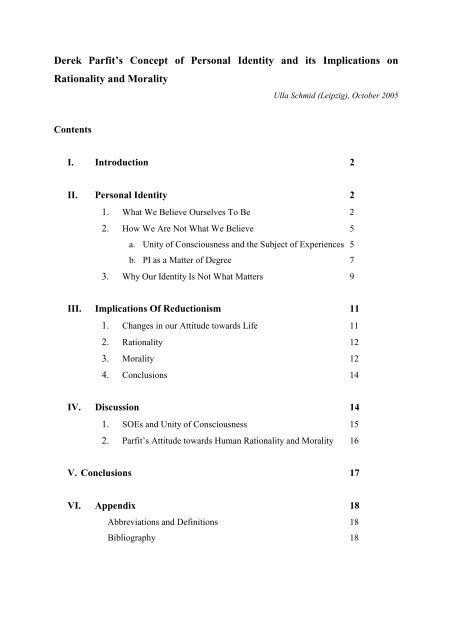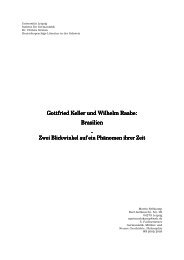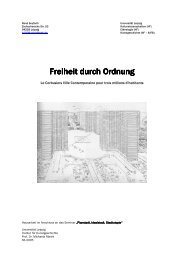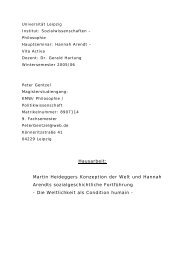Derek Parfit's Concept of Personal Identity and its Implications on ...
Derek Parfit's Concept of Personal Identity and its Implications on ...
Derek Parfit's Concept of Personal Identity and its Implications on ...
Create successful ePaper yourself
Turn your PDF publications into a flip-book with our unique Google optimized e-Paper software.
<str<strong>on</strong>g>Derek</str<strong>on</strong>g> Parfit’s <str<strong>on</strong>g>C<strong>on</strong>cept</str<strong>on</strong>g> <str<strong>on</strong>g>of</str<strong>on</strong>g> <str<strong>on</strong>g>Pers<strong>on</strong>al</str<strong>on</strong>g> <str<strong>on</strong>g>Identity</str<strong>on</strong>g> <str<strong>on</strong>g>and</str<strong>on</strong>g> <str<strong>on</strong>g>its</str<strong>on</strong>g> <str<strong>on</strong>g>Implicati<strong>on</strong>s</str<strong>on</strong>g> <strong>on</strong>Rati<strong>on</strong>ality <str<strong>on</strong>g>and</str<strong>on</strong>g> MoralityUlla Schmid (Leipzig), October 2005C<strong>on</strong>tentsI. Introducti<strong>on</strong> 2II. <str<strong>on</strong>g>Pers<strong>on</strong>al</str<strong>on</strong>g> <str<strong>on</strong>g>Identity</str<strong>on</strong>g> 21. What We Believe Ourselves To Be 22. How We Are Not What We Believe 5a. Unity <str<strong>on</strong>g>of</str<strong>on</strong>g> C<strong>on</strong>sciousness <str<strong>on</strong>g>and</str<strong>on</strong>g> the Subject <str<strong>on</strong>g>of</str<strong>on</strong>g> Experiences 5b. PI as a Matter <str<strong>on</strong>g>of</str<strong>on</strong>g> Degree 73. Why Our <str<strong>on</strong>g>Identity</str<strong>on</strong>g> Is Not What Matters 9III. <str<strong>on</strong>g>Implicati<strong>on</strong>s</str<strong>on</strong>g> Of Reducti<strong>on</strong>ism 111. Changes in our Attitude towards Life 112. Rati<strong>on</strong>ality 123. Morality 124. C<strong>on</strong>clusi<strong>on</strong>s 14IV. Discussi<strong>on</strong> 141. SOEs <str<strong>on</strong>g>and</str<strong>on</strong>g> Unity <str<strong>on</strong>g>of</str<strong>on</strong>g> C<strong>on</strong>sciousness 152. Parfit’s Attitude towards Human Rati<strong>on</strong>ality <str<strong>on</strong>g>and</str<strong>on</strong>g> Morality 16V. C<strong>on</strong>clusi<strong>on</strong>s 17VI. Appendix 18Abbreviati<strong>on</strong>s <str<strong>on</strong>g>and</str<strong>on</strong>g> Definiti<strong>on</strong>s 18Bibliography 18
I. Introducti<strong>on</strong>Within his large work “Reas<strong>on</strong>s <str<strong>on</strong>g>and</str<strong>on</strong>g> Pers<strong>on</strong>s”, <str<strong>on</strong>g>Derek</str<strong>on</strong>g> Parfit drafts a c<strong>on</strong>cept <str<strong>on</strong>g>of</str<strong>on</strong>g> <str<strong>on</strong>g>Pers<strong>on</strong>al</str<strong>on</strong>g><str<strong>on</strong>g>Identity</str<strong>on</strong>g> examining the questi<strong>on</strong>s c<strong>on</strong>cerning what a pers<strong>on</strong> is <str<strong>on</strong>g>and</str<strong>on</strong>g> in what a pers<strong>on</strong>’s existenceover time c<strong>on</strong>sists. Thereby, he intends to prove Reducti<strong>on</strong>ism to be the sole logicallycoherent rec<strong>on</strong>structi<strong>on</strong> <str<strong>on</strong>g>of</str<strong>on</strong>g> reality <str<strong>on</strong>g>and</str<strong>on</strong>g> thus should provide the fundamental Theory X <str<strong>on</strong>g>of</str<strong>on</strong>g>morality <str<strong>on</strong>g>and</str<strong>on</strong>g> rati<strong>on</strong>ality his whole work is aimed at.In the following, I will rec<strong>on</strong>struct Parfit’s argumentati<strong>on</strong> <str<strong>on</strong>g>and</str<strong>on</strong>g> <str<strong>on</strong>g>its</str<strong>on</strong>g> implicati<strong>on</strong>s <strong>on</strong>rati<strong>on</strong>ality <str<strong>on</strong>g>and</str<strong>on</strong>g> morality, presented in Part Three “<str<strong>on</strong>g>Pers<strong>on</strong>al</str<strong>on</strong>g> <str<strong>on</strong>g>Identity</str<strong>on</strong>g>”, before discussing somequesti<strong>on</strong>s raised by his point <str<strong>on</strong>g>of</str<strong>on</strong>g> view. This essay c<strong>on</strong>centrates <strong>on</strong> chapter ten to twelve, as theyintroduce the theory <str<strong>on</strong>g>of</str<strong>on</strong>g> Reducti<strong>on</strong>ism, fourteen <str<strong>on</strong>g>and</str<strong>on</strong>g> fifteen which present Parfit’s c<strong>on</strong>clusi<strong>on</strong>sc<strong>on</strong>cerning morality <str<strong>on</strong>g>and</str<strong>on</strong>g> rati<strong>on</strong>ality.II. <str<strong>on</strong>g>Pers<strong>on</strong>al</str<strong>on</strong>g> <str<strong>on</strong>g>Identity</str<strong>on</strong>g>1. What We Believe Ourselves To BeTo introduce his main questi<strong>on</strong>s about the nature <str<strong>on</strong>g>of</str<strong>on</strong>g> a pers<strong>on</strong> <str<strong>on</strong>g>and</str<strong>on</strong>g> <str<strong>on</strong>g>of</str<strong>on</strong>g> identity over time,Parfit gives a science-ficti<strong>on</strong>al example 1 . The c<strong>on</strong>siderati<strong>on</strong> <str<strong>on</strong>g>of</str<strong>on</strong>g> mere imaginary cases willencourage us to take an intuitive positi<strong>on</strong> regarding the questi<strong>on</strong>, as to whether two people attwo different times are <strong>on</strong>e <str<strong>on</strong>g>and</str<strong>on</strong>g> the same (oats.) pers<strong>on</strong>, since our beliefs about ourselvesbecome most explicit when c<strong>on</strong>sidering imaginary cases (200) 2 . Some <str<strong>on</strong>g>of</str<strong>on</strong>g> these “naturalbeliefs” are shown to be relying up<strong>on</strong> false assumpti<strong>on</strong>s. By analysing <str<strong>on</strong>g>and</str<strong>on</strong>g> correcting themParfit wants to argue in favour <str<strong>on</strong>g>of</str<strong>on</strong>g> his underst<str<strong>on</strong>g>and</str<strong>on</strong>g>ing <str<strong>on</strong>g>of</str<strong>on</strong>g> a pers<strong>on</strong>’s existence <str<strong>on</strong>g>and</str<strong>on</strong>g> to present <str<strong>on</strong>g>its</str<strong>on</strong>g>implicati<strong>on</strong>s <strong>on</strong> morality.First, two kinds <str<strong>on</strong>g>of</str<strong>on</strong>g> identity are differentiated: Numerical identity which means to be oats.,<str<strong>on</strong>g>and</str<strong>on</strong>g> qualitative identity, a syn<strong>on</strong>ym <str<strong>on</strong>g>of</str<strong>on</strong>g> exact similarity. The questi<strong>on</strong> <str<strong>on</strong>g>of</str<strong>on</strong>g> what characterises PIo. t. as well as our c<strong>on</strong>cern about our future chiefly refer to numerical identity though thismight be influenced by changes in qualitative identity.Approaching his central questi<strong>on</strong>s “What is the nature <str<strong>on</strong>g>of</str<strong>on</strong>g> a pers<strong>on</strong>?” <str<strong>on</strong>g>and</str<strong>on</strong>g> “What is it thatmakes a pers<strong>on</strong> at two different times oats. pers<strong>on</strong>?”, Parfit at first gives two criteria to answerthe latter as by doing so he can provide parts <str<strong>on</strong>g>of</str<strong>on</strong>g> an answer to the first (202).1 Compare the example <str<strong>on</strong>g>of</str<strong>on</strong>g> Teletransportati<strong>on</strong>, secti<strong>on</strong> 75.2 All page numbers refer to <str<strong>on</strong>g>Derek</str<strong>on</strong>g> Parfit: Reas<strong>on</strong>s <str<strong>on</strong>g>and</str<strong>on</strong>g> Pers<strong>on</strong>, Oxford, Clarend<strong>on</strong> Press, 1984.2
The Physical Criteri<strong>on</strong> (ΦK) focuses <strong>on</strong> the physical persistence <str<strong>on</strong>g>of</str<strong>on</strong>g> a pers<strong>on</strong>, namely thespatio-temporal c<strong>on</strong>tinuity <str<strong>on</strong>g>of</str<strong>on</strong>g> his brain <str<strong>on</strong>g>and</str<strong>on</strong>g> body. This means, that there is a c<strong>on</strong>tinuous linebetween the past <str<strong>on</strong>g>and</str<strong>on</strong>g> the present pers<strong>on</strong> <str<strong>on</strong>g>and</str<strong>on</strong>g> that at each point there was a pers<strong>on</strong> whoseexistence was partly caused by the existence <str<strong>on</strong>g>of</str<strong>on</strong>g> the immediately preceding pers<strong>on</strong>. Physicalc<strong>on</strong>tinuity (ΦC) includes states, in which <strong>on</strong>ly the comp<strong>on</strong>ents 3 <str<strong>on</strong>g>of</str<strong>on</strong>g> a whole exist, <str<strong>on</strong>g>and</str<strong>on</strong>g> thereplacement <str<strong>on</strong>g>of</str<strong>on</strong>g> certain comp<strong>on</strong>ents with exactly similar spares.Parfit c<strong>on</strong>cludesThe Physical Criteri<strong>on</strong> [204]: (1) What is necessary is […] the c<strong>on</strong>tinued existence<str<strong>on</strong>g>of</str<strong>on</strong>g> enough <str<strong>on</strong>g>of</str<strong>on</strong>g> the brain […]. X today is oats. pers<strong>on</strong> as Y at some past time iff (2)enough <str<strong>on</strong>g>of</str<strong>on</strong>g> Y’s brain c<strong>on</strong>tinued to exist, <str<strong>on</strong>g>and</str<strong>on</strong>g> is now X’s brain, <str<strong>on</strong>g>and</str<strong>on</strong>g> (3) there does notexist a different pers<strong>on</strong> who also has enough <str<strong>on</strong>g>of</str<strong>on</strong>g> Y’s brain. (4) PI o. t. just c<strong>on</strong>sists inthe holding <str<strong>on</strong>g>of</str<strong>on</strong>g> facts like (2) <str<strong>on</strong>g>and</str<strong>on</strong>g> (3).On a psychological level, Parfit differentiates two possibilities <str<strong>on</strong>g>of</str<strong>on</strong>g> explaining identity o. t.:either there is a certain mental entity (like a Cartesian Ego) whose c<strong>on</strong>tinuity resembles ΦC,or PI o. t. rather c<strong>on</strong>sists in psychological c<strong>on</strong>tinuity (ΨC), an overlapping chain <str<strong>on</strong>g>of</str<strong>on</strong>g>c<strong>on</strong>necti<strong>on</strong>s between certain psychological features 4 . These can principally hold to differentextents; whereas psychological c<strong>on</strong>nectedness involves <strong>on</strong>ly some particular directc<strong>on</strong>necti<strong>on</strong>s whereas ΨC is c<strong>on</strong>stituted by overlapping chains <str<strong>on</strong>g>of</str<strong>on</strong>g> str<strong>on</strong>g c<strong>on</strong>nectedness (206).Whereas str<strong>on</strong>g (direct) c<strong>on</strong>nectedness lacks transitivity <str<strong>on</strong>g>and</str<strong>on</strong>g> therefore cannot be <str<strong>on</strong>g>its</str<strong>on</strong>g>elf acriteri<strong>on</strong> <str<strong>on</strong>g>of</str<strong>on</strong>g> PI o. t., ΨC provides PI o. t. because <str<strong>on</strong>g>of</str<strong>on</strong>g> <str<strong>on</strong>g>its</str<strong>on</strong>g> overlapping c<strong>on</strong>necti<strong>on</strong>s 5 .Analogous to ΦK, there isThe Psychological Criteri<strong>on</strong> [ΨK, p. 207]: (1) There is ΨC iff there are overlappingchains <str<strong>on</strong>g>of</str<strong>on</strong>g> str<strong>on</strong>g c<strong>on</strong>nectedness. X today is oats. pers<strong>on</strong> as Y at some past time iff (2)X is psychologically c<strong>on</strong>tinuous with Y, (3) this c<strong>on</strong>tinuity has the right kind <str<strong>on</strong>g>of</str<strong>on</strong>g>cause, <str<strong>on</strong>g>and</str<strong>on</strong>g> (4) there does not exist a different pers<strong>on</strong> who is also psychologicallyc<strong>on</strong>tinuous with Y. (5) PI o. t. just c<strong>on</strong>sists in the holding <str<strong>on</strong>g>of</str<strong>on</strong>g> facts like (2) to (4).The “right kind <str<strong>on</strong>g>of</str<strong>on</strong>g> cause” menti<strong>on</strong>ed in sentence (3) could be any cause.Later it will be shown, why Parfit includes requirements (3) <str<strong>on</strong>g>and</str<strong>on</strong>g> (4) <strong>on</strong> ΦK as well as (4) <str<strong>on</strong>g>and</str<strong>on</strong>g>(5) <strong>on</strong> the ΨK, the specificati<strong>on</strong> <str<strong>on</strong>g>of</str<strong>on</strong>g> (3) is necessary to cover Parfit’s imaginary examples.3 E. g. a wooden ship whose comp<strong>on</strong>ents are exchanged from time to time (203 ).4 Hereby Parfit revises John Locke’s c<strong>on</strong>cept that direct memory is the main c<strong>on</strong>stituent <str<strong>on</strong>g>of</str<strong>on</strong>g> PI o. t., compare p.205.5 Direct c<strong>on</strong>nectedness means the holding <str<strong>on</strong>g>of</str<strong>on</strong>g> direct c<strong>on</strong>necti<strong>on</strong>s between two pers<strong>on</strong>s at two points t¹ (today) <str<strong>on</strong>g>and</str<strong>on</strong>g>t² (at some past time), <str<strong>on</strong>g>and</str<strong>on</strong>g> between t² <str<strong>on</strong>g>and</str<strong>on</strong>g> t³ (even further in the past) without c<strong>on</strong>cluding that there are the samec<strong>on</strong>necti<strong>on</strong>s between t¹ <str<strong>on</strong>g>and</str<strong>on</strong>g> t³. In c<strong>on</strong>trast, overlapping chains <str<strong>on</strong>g>of</str<strong>on</strong>g> c<strong>on</strong>nectedness exactly imply this c<strong>on</strong>clusi<strong>on</strong>.3
Having found these criteria to be essential features <str<strong>on</strong>g>of</str<strong>on</strong>g> PI o. t., this is explained as involving<strong>on</strong>ly a number <str<strong>on</strong>g>of</str<strong>on</strong>g> particular facts which can be described impers<strong>on</strong>ally, i. e. neither ascribingthem to a particular pers<strong>on</strong> nor presupposing this pers<strong>on</strong>’s existence. This impers<strong>on</strong>alitywhich is characteristic <str<strong>on</strong>g>of</str<strong>on</strong>g> the Reducti<strong>on</strong>ist View Parfit supports cannot even be affected if indescribing the c<strong>on</strong>tents <str<strong>on</strong>g>of</str<strong>on</strong>g> a particular thought a pers<strong>on</strong> is menti<strong>on</strong>ed 6 (210).In c<strong>on</strong>trast to Reducti<strong>on</strong>ism another view <str<strong>on</strong>g>of</str<strong>on</strong>g> PI o. t. is sketched, <str<strong>on</strong>g>and</str<strong>on</strong>g> vehemently disputedthroughout the following discussi<strong>on</strong>. On N<strong>on</strong>-Reducti<strong>on</strong>ism, PI c<strong>on</strong>sists in a “further fact”(210) bey<strong>on</strong>d ΦC or ΨC, i. e. an ideal entity which exists detached from provable facts. Most<str<strong>on</strong>g>of</str<strong>on</strong>g> Parfit’s attacks against this view aim at the Cartesian underst<str<strong>on</strong>g>and</str<strong>on</strong>g>ing <str<strong>on</strong>g>of</str<strong>on</strong>g> separately existingentities (SEEs) as pure mental substances, although moderate theories <str<strong>on</strong>g>of</str<strong>on</strong>g> a further fact aredismissed in the same way.Instead, a pers<strong>on</strong>’s existence“just c<strong>on</strong>sists in the existence <str<strong>on</strong>g>of</str<strong>on</strong>g> a brain <str<strong>on</strong>g>and</str<strong>on</strong>g> body, <str<strong>on</strong>g>and</str<strong>on</strong>g> the occurrence <str<strong>on</strong>g>of</str<strong>on</strong>g> a series <str<strong>on</strong>g>of</str<strong>on</strong>g>interrelated physical <str<strong>on</strong>g>and</str<strong>on</strong>g> mental events” [211],<str<strong>on</strong>g>and</str<strong>on</strong>g> therefore, despite <str<strong>on</strong>g>of</str<strong>on</strong>g> the actual existence <str<strong>on</strong>g>of</str<strong>on</strong>g> pers<strong>on</strong>s,“a complete descripti<strong>on</strong> <str<strong>on</strong>g>of</str<strong>on</strong>g> reality [can be given] without claiming that pers<strong>on</strong>s exist”[212] 7 .There is some importance laid up<strong>on</strong> this way <str<strong>on</strong>g>of</str<strong>on</strong>g> describing reality impers<strong>on</strong>ally assumingthat by the descripti<strong>on</strong> <str<strong>on</strong>g>of</str<strong>on</strong>g> the c<strong>on</strong>stituents <str<strong>on</strong>g>of</str<strong>on</strong>g> a pers<strong>on</strong>’s existence this is already implicitlyincluded, <str<strong>on</strong>g>and</str<strong>on</strong>g> that an additi<strong>on</strong>al menti<strong>on</strong> <str<strong>on</strong>g>of</str<strong>on</strong>g> this pers<strong>on</strong> would be redundant.Bey<strong>on</strong>d impers<strong>on</strong>ality, a sec<strong>on</strong>d important c<strong>on</strong>sequence <str<strong>on</strong>g>of</str<strong>on</strong>g> Reducti<strong>on</strong>ism is that PI cansometimes be indeterminate 8 : The questi<strong>on</strong>, if a pers<strong>on</strong> at two different times is oats. pers<strong>on</strong>cannot always be answered by “Yes” or “No”, though all relevant circumstances can becompletely described. Parfit calls such a kind <str<strong>on</strong>g>of</str<strong>on</strong>g> questi<strong>on</strong> empty, i. e. c<strong>on</strong>cerning a certainprocess there is <strong>on</strong>ly <strong>on</strong>e outcome to c<strong>on</strong>sider, differences in descripti<strong>on</strong>s are merely differentinterpretati<strong>on</strong>s <str<strong>on</strong>g>of</str<strong>on</strong>g> the same facts. If we now choose <strong>on</strong>e answer, this choice will be arbitrarilyset without any plausible reas<strong>on</strong>s 9 .6 The reference <str<strong>on</strong>g>of</str<strong>on</strong>g> pers<strong>on</strong>s within thoughts does not imply their existence, to refuse self-referential thoughts (inFirst-Pers<strong>on</strong>-Mode) to be an indicator <str<strong>on</strong>g>of</str<strong>on</strong>g> the thinker’s identity with the c<strong>on</strong>tained pers<strong>on</strong>, Parfit establishes thec<strong>on</strong>cept <str<strong>on</strong>g>of</str<strong>on</strong>g> quasi-memory (220 ff.).7 One <str<strong>on</strong>g>of</str<strong>on</strong>g> Parfit’s favourite analogies to the nature <str<strong>on</strong>g>of</str<strong>on</strong>g> pers<strong>on</strong>s is the nature <str<strong>on</strong>g>of</str<strong>on</strong>g> nati<strong>on</strong>s <strong>on</strong>ly including actual factssuch as citizens or a certain territory.8 Indeterminacy assumes requirements 4 <strong>on</strong> ΦC <str<strong>on</strong>g>and</str<strong>on</strong>g> 5 <strong>on</strong> ΨC, meaning the lack <str<strong>on</strong>g>of</str<strong>on</strong>g> SEEs.9 Applied to PI, this means that, in case <str<strong>on</strong>g>of</str<strong>on</strong>g> merely reduced holding <str<strong>on</strong>g>of</str<strong>on</strong>g> ΨC, the questi<strong>on</strong> if a particular pers<strong>on</strong>“survives” (= is still oats.) a certain development cannot be plausibly answered. Compare the re-establishment <str<strong>on</strong>g>of</str<strong>on</strong>g>clubs (213 f.).4
ascribe thoughts to thinkers as we do in everyday-language, <str<strong>on</strong>g>and</str<strong>on</strong>g> even less are we coerced todeduce an SEE, since an impers<strong>on</strong>al descripti<strong>on</strong> <str<strong>on</strong>g>of</str<strong>on</strong>g> mental experiences can report the factscompletely (225).Moreover, even the ascripti<strong>on</strong> <str<strong>on</strong>g>of</str<strong>on</strong>g> thoughts to different thinkers or the menti<strong>on</strong> <str<strong>on</strong>g>of</str<strong>on</strong>g> differentpeople within these thoughts can be realised impers<strong>on</strong>ally, though in a more complicatedway 16 :In the particular life that c<strong>on</strong>tains the thinking <str<strong>on</strong>g>of</str<strong>on</strong>g> the thought that is expressed by theutterance <str<strong>on</strong>g>of</str<strong>on</strong>g> this sentence, it is thought: … [226].Therefore, Parfit c<strong>on</strong>siders an impers<strong>on</strong>al explanati<strong>on</strong> <str<strong>on</strong>g>of</str<strong>on</strong>g> the unity <str<strong>on</strong>g>of</str<strong>on</strong>g> a pers<strong>on</strong>’s life to bemost plausible: Even without claiming that experiences are actually had by subjects, “wecould describe the interrelati<strong>on</strong>s between all <str<strong>on</strong>g>of</str<strong>on</strong>g> the mental <str<strong>on</strong>g>and</str<strong>on</strong>g> physical events that togetherc<strong>on</strong>stitute a particular pers<strong>on</strong>’s life” [226].b. PI as a Matter <str<strong>on</strong>g>of</str<strong>on</strong>g> DegreeAs there is no plausible reference to an SEE or an SOE c<strong>on</strong>sidering the identity <str<strong>on</strong>g>of</str<strong>on</strong>g> <strong>on</strong>epers<strong>on</strong> at two different times, how can we diagnose PI o. t. using the psychological <str<strong>on</strong>g>and</str<strong>on</strong>g>/or thephysical criteri<strong>on</strong>?Temporarily assuming that his physical state maintains, a pers<strong>on</strong>’s life throughout a certainperiod <str<strong>on</strong>g>of</str<strong>on</strong>g> time basically c<strong>on</strong>sists in varied changes in his psychological features. Depending<strong>on</strong> the importance <str<strong>on</strong>g>of</str<strong>on</strong>g> these changes, the degree <str<strong>on</strong>g>of</str<strong>on</strong>g> ΨC can be more or less reduced: This isportrayed by the Psychological Spectrum (231 ff.) ranging from full ΨC to no psychologicalc<strong>on</strong>necti<strong>on</strong> at all.Now we have to decide which degree <str<strong>on</strong>g>of</str<strong>on</strong>g> holding psychological c<strong>on</strong>necti<strong>on</strong>s within thespectrum is sufficient to state a pers<strong>on</strong>’s “survival” throughout the relevant period (231): Atthe “near end” (almost full ΨC) <str<strong>on</strong>g>of</str<strong>on</strong>g> the spectrum, the pers<strong>on</strong>’s “survival” 17 is as obvious as his“death” is at the “far end”. C<strong>on</strong>cerning the middle <str<strong>on</strong>g>of</str<strong>on</strong>g> the spectrum, the crucial point betweendeath <str<strong>on</strong>g>and</str<strong>on</strong>g> survival is not easy to fix: On the <strong>on</strong>e h<str<strong>on</strong>g>and</str<strong>on</strong>g>, there are <strong>on</strong>ly slight differences indegree between the cases in the spectrum, but <strong>on</strong> the other h<str<strong>on</strong>g>and</str<strong>on</strong>g> the difference betweensurvival <str<strong>on</strong>g>and</str<strong>on</strong>g> death is intuitively supposed to be significant. Thus, the decisi<strong>on</strong> up to whichpercentage <str<strong>on</strong>g>of</str<strong>on</strong>g> psychological c<strong>on</strong>necti<strong>on</strong>s PI is granted must be taken arbitrarily without any16 The natural use <str<strong>on</strong>g>of</str<strong>on</strong>g> pers<strong>on</strong>al pr<strong>on</strong>ouns just seems to serve simplificati<strong>on</strong> <str<strong>on</strong>g>of</str<strong>on</strong>g> every-day language.17 Survival means that the pers<strong>on</strong> remains oats. throughout the period, he is identical at both times whereas“death” assumes merely a few c<strong>on</strong>necti<strong>on</strong>s left7
our c<strong>on</strong>tinuous existence, this belief should be ab<str<strong>on</strong>g>and</str<strong>on</strong>g><strong>on</strong>ed in favour <str<strong>on</strong>g>of</str<strong>on</strong>g> Reducti<strong>on</strong>ism claimingRelati<strong>on</strong> R to be what matters <str<strong>on</strong>g>and</str<strong>on</strong>g> denying the existence <str<strong>on</strong>g>of</str<strong>on</strong>g> a further fact, <str<strong>on</strong>g>and</str<strong>on</strong>g> thedeterminati<strong>on</strong> <str<strong>on</strong>g>of</str<strong>on</strong>g> PI in every case (241).3. Why Our <str<strong>on</strong>g>Identity</str<strong>on</strong>g> Is Not What MattersSubsequent to his rejecti<strong>on</strong> <str<strong>on</strong>g>of</str<strong>on</strong>g> the determinati<strong>on</strong> <str<strong>on</strong>g>of</str<strong>on</strong>g> PI, Parfit intends the final refutati<strong>on</strong> <str<strong>on</strong>g>of</str<strong>on</strong>g>three N<strong>on</strong>-Reducti<strong>on</strong>ist presumpti<strong>on</strong>s, namely the unity <str<strong>on</strong>g>of</str<strong>on</strong>g> c<strong>on</strong>sciousness, the belief in SEEs,<str<strong>on</strong>g>and</str<strong>on</strong>g> the claim that the degree <str<strong>on</strong>g>of</str<strong>on</strong>g> PI o. t. is significant regarding our permanent existence <str<strong>on</strong>g>and</str<strong>on</strong>g>our c<strong>on</strong>cepts <str<strong>on</strong>g>of</str<strong>on</strong>g> rati<strong>on</strong>ality <str<strong>on</strong>g>and</str<strong>on</strong>g> morality.For this purpose, he c<strong>on</strong>templates the equal divisi<strong>on</strong> <str<strong>on</strong>g>of</str<strong>on</strong>g> a pers<strong>on</strong>’s c<strong>on</strong>sciousness in twostreams, each <str<strong>on</strong>g>of</str<strong>on</strong>g> them fully psychologically c<strong>on</strong>tinuous with the pers<strong>on</strong>’s previous unitedc<strong>on</strong>sciousness (245 ff.).If the unity <str<strong>on</strong>g>of</str<strong>on</strong>g> c<strong>on</strong>sciousness is explained by <str<strong>on</strong>g>its</str<strong>on</strong>g> SOE, the scenario <str<strong>on</strong>g>of</str<strong>on</strong>g> the divisi<strong>on</strong> <str<strong>on</strong>g>of</str<strong>on</strong>g> apers<strong>on</strong>’s mind into two equal streams <str<strong>on</strong>g>of</str<strong>on</strong>g> c<strong>on</strong>sciousness must imply that there are two distinctSOEs related at oats. time to oats. pers<strong>on</strong> – which is regarded as being implausible 23 <str<strong>on</strong>g>and</str<strong>on</strong>g>thereby additi<strong>on</strong>al empirical 24 evidence against claiming SOE to be the crucial c<strong>on</strong>stituent <str<strong>on</strong>g>of</str<strong>on</strong>g>PI (249).In c<strong>on</strong>trast, a Reducti<strong>on</strong>ist simply describes the unity <str<strong>on</strong>g>of</str<strong>on</strong>g> c<strong>on</strong>sciousness through severalexperiences being co-c<strong>on</strong>scious, i. e. being had at oats. time, without laying importance to the– possibly different – subjects they bel<strong>on</strong>g to (250).According to Parfit’s view, subjects in fact <strong>on</strong>ly exist because we create them by ascribingexperiences to something having these experiences, but they are necessary, neither fordescribing pers<strong>on</strong>s nor for explaining their lives’ unity.On the c<strong>on</strong>trary, he claims that unity <str<strong>on</strong>g>of</str<strong>on</strong>g> experiences does not exist if they are had within aparticular pers<strong>on</strong>’s life, but that these experiences bel<strong>on</strong>g to a particular pers<strong>on</strong>’s life if theyare specially related 25 (252).The case <str<strong>on</strong>g>of</str<strong>on</strong>g> dividing merely a pers<strong>on</strong>’s c<strong>on</strong>sciousness <strong>on</strong>ly provides further counterevidenceagainst the belief in SEEs whereas applying to the ΦC the pers<strong>on</strong>’s identity o. t. is23 One pers<strong>on</strong> cannot plausibly be two pers<strong>on</strong>s for a certain time, <str<strong>on</strong>g>and</str<strong>on</strong>g> as the pers<strong>on</strong> before the divisi<strong>on</strong> is not <strong>on</strong>e<str<strong>on</strong>g>of</str<strong>on</strong>g> the two SOEs during the time <str<strong>on</strong>g>of</str<strong>on</strong>g> divisi<strong>on</strong>, this scenario must either include even three SOEs, or there must beSOEs that are not pers<strong>on</strong>s (250).24 Compare p.245: the c<strong>on</strong>sequences <str<strong>on</strong>g>of</str<strong>on</strong>g> cerebral surgery for percepti<strong>on</strong> <str<strong>on</strong>g>and</str<strong>on</strong>g> c<strong>on</strong>sciousness.25 Therefore: not L (comm<strong>on</strong> life) U (unity), but U L.9
not affected <str<strong>on</strong>g>and</str<strong>on</strong>g> still can be c<strong>on</strong>sidered to be the deciding criteri<strong>on</strong> in diagnosing hisc<strong>on</strong>tinued existence.This claim is challenged by Parfit’s next example: the transplantati<strong>on</strong> <str<strong>on</strong>g>of</str<strong>on</strong>g> an equally splitbrain into two identical bodies (secti<strong>on</strong> 89, p. 253 ff.). As Relati<strong>on</strong> R is holding between theprevious pers<strong>on</strong> Y <str<strong>on</strong>g>and</str<strong>on</strong>g> either present pers<strong>on</strong> X to the same extent, the questi<strong>on</strong> as to who <str<strong>on</strong>g>of</str<strong>on</strong>g>both X is identical with Y is empty 26 , the outcome can be described as “two future people,each <str<strong>on</strong>g>of</str<strong>on</strong>g> whom […] fully psychologically c<strong>on</strong>tinuous with” the past pers<strong>on</strong> (260). Thus, thecase <str<strong>on</strong>g>of</str<strong>on</strong>g> divisi<strong>on</strong> argues that ΨC does not presuppose PI, too, since it is not possible that bothX are identical with Y despite <str<strong>on</strong>g>of</str<strong>on</strong>g> being fully psychologically c<strong>on</strong>nected with him (261) 27 .What are the reacti<strong>on</strong>s to this case? Parfit regards Y’s divisi<strong>on</strong> as being “as good asordinary survival” (261) since the <strong>on</strong>ly obstacle to state Y’s PI o. t. is his duplicati<strong>on</strong> whereasthe ΨK as well as the ΦK is perfectly met. The main reas<strong>on</strong> for intuitive suspici<strong>on</strong> againstvaluing the divisi<strong>on</strong> case positively c<strong>on</strong>sists in the c<strong>on</strong>flict between duplicati<strong>on</strong> <str<strong>on</strong>g>and</str<strong>on</strong>g> the“natural” c<strong>on</strong>cept respectively the original meaning <str<strong>on</strong>g>of</str<strong>on</strong>g> “identity”.Therefore, Parfit c<strong>on</strong>cludes, PI cannot be the crucial feature when being c<strong>on</strong>cerned about<strong>on</strong>e’s own future, it is rather Relati<strong>on</strong> R which matters because it does not require a <strong>on</strong>e-to<strong>on</strong>erelati<strong>on</strong> between X today <str<strong>on</strong>g>and</str<strong>on</strong>g> Y at some past time compared with PI c<strong>on</strong>sisting in theunique holding <str<strong>on</strong>g>of</str<strong>on</strong>g> Relati<strong>on</strong> R: PI = R + U (263) 28 . For R expressing the “intrinsic nature”(263) <str<strong>on</strong>g>of</str<strong>on</strong>g> the relati<strong>on</strong> between X <str<strong>on</strong>g>and</str<strong>on</strong>g> Y, R is the more important c<strong>on</strong>stituent <str<strong>on</strong>g>of</str<strong>on</strong>g> PI with U <strong>on</strong>lyslightly changing R’s value.Now I will briefly summarise the Reducti<strong>on</strong>ist View <str<strong>on</strong>g>of</str<strong>on</strong>g> existence <str<strong>on</strong>g>and</str<strong>on</strong>g> identity <str<strong>on</strong>g>of</str<strong>on</strong>g> pers<strong>on</strong>sbefore rec<strong>on</strong>structing Parfit’s deducti<strong>on</strong> <str<strong>on</strong>g>of</str<strong>on</strong>g> <str<strong>on</strong>g>its</str<strong>on</strong>g> implicati<strong>on</strong>s up<strong>on</strong> rati<strong>on</strong>ality <str<strong>on</strong>g>and</str<strong>on</strong>g> morality.According to the Reducti<strong>on</strong>ist View, pers<strong>on</strong>s indeed do exist, distinct from their brains <str<strong>on</strong>g>and</str<strong>on</strong>g>bodies, <str<strong>on</strong>g>and</str<strong>on</strong>g> experiences, though they are not SEEs: A pers<strong>on</strong>’s existence <strong>on</strong>ly c<strong>on</strong>sists in aparticular brain <str<strong>on</strong>g>and</str<strong>on</strong>g> body, <str<strong>on</strong>g>and</str<strong>on</strong>g> a series <str<strong>on</strong>g>of</str<strong>on</strong>g> mental <str<strong>on</strong>g>and</str<strong>on</strong>g> physical events.Thus, <str<strong>on</strong>g>Pers<strong>on</strong>al</str<strong>on</strong>g> <str<strong>on</strong>g>Identity</str<strong>on</strong>g> over time just c<strong>on</strong>sists in ΨC <str<strong>on</strong>g>and</str<strong>on</strong>g> ΦC in a <strong>on</strong>e-to-<strong>on</strong>e form <str<strong>on</strong>g>and</str<strong>on</strong>g>therefore is unlikely to be the feature which matters in a pers<strong>on</strong>’s permanent existence.26 This time, the emptiness <str<strong>on</strong>g>of</str<strong>on</strong>g> the questi<strong>on</strong> allows a “best descripti<strong>on</strong>” (260) <str<strong>on</strong>g>of</str<strong>on</strong>g> the outcome: Y would be neitherX, therefore: Y will not survive (259).27 This example proves the necessity <str<strong>on</strong>g>of</str<strong>on</strong>g> requirements 3 <strong>on</strong> ΦK <str<strong>on</strong>g>and</str<strong>on</strong>g> 4 <strong>on</strong> ΨK.28 U describes the fact <str<strong>on</strong>g>of</str<strong>on</strong>g> a <strong>on</strong>e-to-<strong>on</strong>e relati<strong>on</strong>.10
Unity <str<strong>on</strong>g>of</str<strong>on</strong>g> C<strong>on</strong>sciousness is explained by the ΨC as <strong>on</strong>e state <str<strong>on</strong>g>of</str<strong>on</strong>g> being aware <str<strong>on</strong>g>of</str<strong>on</strong>g> differentsimultaneous mental events, the Subject <str<strong>on</strong>g>of</str<strong>on</strong>g> Experiences depending up<strong>on</strong> the relati<strong>on</strong> betweenthese experiences (<str<strong>on</strong>g>and</str<strong>on</strong>g> not vice versa).As there is no SEE, the carrier <str<strong>on</strong>g>of</str<strong>on</strong>g> ΨC is the brain whose ΦC can be reduced to any degree.Proved by the Psychological, the Physical, <str<strong>on</strong>g>and</str<strong>on</strong>g> the Combined Spectrum, PI is not alwaysdeterminate, <str<strong>on</strong>g>and</str<strong>on</strong>g> the decisi<strong>on</strong> whether a pers<strong>on</strong> X today is oats. as a pers<strong>on</strong> Y at some pasttime sometimes is an arbitrary answer to an empty questi<strong>on</strong>.Though our “natural beliefs” in determinati<strong>on</strong> <str<strong>on</strong>g>and</str<strong>on</strong>g> importance <str<strong>on</strong>g>of</str<strong>on</strong>g> identity are disproved byReducti<strong>on</strong>ism <strong>on</strong> an abstract level which allows the c<strong>on</strong>clusi<strong>on</strong> that the mere holding <str<strong>on</strong>g>of</str<strong>on</strong>g>Relati<strong>on</strong> R without any uniqueness is as good as ordinary survival, Parfit himself adm<str<strong>on</strong>g>its</str<strong>on</strong>g> thatit is “hard to believe” <str<strong>on</strong>g>and</str<strong>on</strong>g> he himself “would never lose [his] intuitive belief in the N<strong>on</strong>-Reducti<strong>on</strong>ist View” (280).III. <str<strong>on</strong>g>Implicati<strong>on</strong>s</str<strong>on</strong>g> Of Reducti<strong>on</strong>ismAfter introducing Reducti<strong>on</strong>ism, Parfit presents some implicati<strong>on</strong>s which this view <str<strong>on</strong>g>of</str<strong>on</strong>g> PIprovides regarding our attitudes towards life, <str<strong>on</strong>g>and</str<strong>on</strong>g> our c<strong>on</strong>cepts <str<strong>on</strong>g>of</str<strong>on</strong>g> rati<strong>on</strong>ality <str<strong>on</strong>g>and</str<strong>on</strong>g> morality.1. Changes in our Attitudes towards LifeParfit pathetically claims the “Liberati<strong>on</strong> from the Self” (281), meaning that since there isno SEE included in a pers<strong>on</strong>’s permanent existence <str<strong>on</strong>g>and</str<strong>on</strong>g> PI is not what matters, the anxietyabout <strong>on</strong>e’s own future diminishes. Moreover, death <str<strong>on</strong>g>and</str<strong>on</strong>g> the separateness <str<strong>on</strong>g>of</str<strong>on</strong>g> people partlylose their importance because the c<strong>on</strong>siderati<strong>on</strong> <str<strong>on</strong>g>of</str<strong>on</strong>g> the future merely focuses <strong>on</strong> relati<strong>on</strong>signoring questi<strong>on</strong>s <strong>on</strong> the persistence <str<strong>on</strong>g>of</str<strong>on</strong>g> pers<strong>on</strong>s. Therefore, a certain similarity <str<strong>on</strong>g>of</str<strong>on</strong>g> relati<strong>on</strong>sbetween a present pers<strong>on</strong> <str<strong>on</strong>g>and</str<strong>on</strong>g> his future self <strong>on</strong> the <strong>on</strong>e h<str<strong>on</strong>g>and</str<strong>on</strong>g>, <str<strong>on</strong>g>and</str<strong>on</strong>g> between the same pers<strong>on</strong><str<strong>on</strong>g>and</str<strong>on</strong>g> another present pers<strong>on</strong> <strong>on</strong> the other h<str<strong>on</strong>g>and</str<strong>on</strong>g> can be stated, <str<strong>on</strong>g>and</str<strong>on</strong>g> the difference between twopers<strong>on</strong>s is reduced.Death <str<strong>on</strong>g>its</str<strong>on</strong>g>elf <strong>on</strong>ly indicates the ceasing <str<strong>on</strong>g>of</str<strong>on</strong>g> certain relati<strong>on</strong>s, namely Relati<strong>on</strong> R, whereas lessdeep indirect relati<strong>on</strong>s to this pers<strong>on</strong> still hold, e. g. by memory. Thus, the pers<strong>on</strong> loses hisquality <str<strong>on</strong>g>of</str<strong>on</strong>g> an SOE, as he does not exist any l<strong>on</strong>ger apart from the c<strong>on</strong>tents <str<strong>on</strong>g>of</str<strong>on</strong>g> other pers<strong>on</strong>s’mental events, but his existence fades away rather slowly instead <str<strong>on</strong>g>of</str<strong>on</strong>g> having a sharp end (281).11
By describing reality completely impers<strong>on</strong>ally as c<strong>on</strong>stituted by varied relati<strong>on</strong>s, a pers<strong>on</strong>can adopt a more objective view <str<strong>on</strong>g>of</str<strong>on</strong>g> his future which allows him to renounce some <str<strong>on</strong>g>of</str<strong>on</strong>g> hisc<strong>on</strong>cern <str<strong>on</strong>g>and</str<strong>on</strong>g> to maintain calmness presently.2. Rati<strong>on</strong>alityAccording to Reducti<strong>on</strong>ism, any rati<strong>on</strong>al anxiety about the future can <strong>on</strong>ly be based <strong>on</strong> theholding <str<strong>on</strong>g>of</str<strong>on</strong>g> certain relati<strong>on</strong>s, especially Relati<strong>on</strong> R, making any c<strong>on</strong>cern about PI o. t.redundant. Thus, Reducti<strong>on</strong>ism provides an objecti<strong>on</strong> to the rati<strong>on</strong>ality <str<strong>on</strong>g>of</str<strong>on</strong>g> a self-centredattitude towards the future since this presupposes <strong>on</strong>e’s own permanent existence (283).Nevertheless, Parfit either does not favour an extreme c<strong>on</strong>cept <str<strong>on</strong>g>of</str<strong>on</strong>g> rati<strong>on</strong>ality rejecting everyc<strong>on</strong>cern about <strong>on</strong>e’s own future self <str<strong>on</strong>g>and</str<strong>on</strong>g> dem<str<strong>on</strong>g>and</str<strong>on</strong>g>ing an indifferent attitude towards life <str<strong>on</strong>g>and</str<strong>on</strong>g>death (307 ff.). Though he cannot disprove <str<strong>on</strong>g>its</str<strong>on</strong>g> plausibility, he argues in favour <str<strong>on</strong>g>of</str<strong>on</strong>g> a moderatec<strong>on</strong>cept: If the c<strong>on</strong>cept <str<strong>on</strong>g>of</str<strong>on</strong>g> SEEs being most important is to refuse, the value <str<strong>on</strong>g>of</str<strong>on</strong>g> Relati<strong>on</strong> R as amotive <str<strong>on</strong>g>of</str<strong>on</strong>g> agency increases <str<strong>on</strong>g>and</str<strong>on</strong>g> hence provides enough reas<strong>on</strong> to being specially c<strong>on</strong>cernedabout a pers<strong>on</strong> being R-related to a particular other pers<strong>on</strong> 29 (311).In additi<strong>on</strong> to the characteristic <str<strong>on</strong>g>of</str<strong>on</strong>g> PI being not always determinate <str<strong>on</strong>g>and</str<strong>on</strong>g> thus failing to be areliable criteri<strong>on</strong> <str<strong>on</strong>g>of</str<strong>on</strong>g> rati<strong>on</strong>al <str<strong>on</strong>g>and</str<strong>on</strong>g> moral c<strong>on</strong>cepts, the fact that ΨC can hold to different degrees<str<strong>on</strong>g>and</str<strong>on</strong>g> that as a result the relati<strong>on</strong> to a pers<strong>on</strong>’s future self can vary in closeness supports anotherobjecti<strong>on</strong> to the claim that self-interest is rati<strong>on</strong>al. Since self-interest requires a pers<strong>on</strong>’s equalc<strong>on</strong>cern about all the parts <str<strong>on</strong>g>of</str<strong>on</strong>g> his future (313) it implies equal c<strong>on</strong>necti<strong>on</strong> between the presentpers<strong>on</strong> <str<strong>on</strong>g>and</str<strong>on</strong>g> all <str<strong>on</strong>g>of</str<strong>on</strong>g> his future selves, <str<strong>on</strong>g>and</str<strong>on</strong>g> thus c<strong>on</strong>tradicts the relativity <str<strong>on</strong>g>of</str<strong>on</strong>g> Relati<strong>on</strong> R.On the c<strong>on</strong>trary, the c<strong>on</strong>cern for <strong>on</strong>e’s future self should rati<strong>on</strong>ally corresp<strong>on</strong>d to thedegree <str<strong>on</strong>g>of</str<strong>on</strong>g> c<strong>on</strong>nectedness between the present <str<strong>on</strong>g>and</str<strong>on</strong>g> the future pers<strong>on</strong>. Therefore, there is acertain discount rate (314) in c<strong>on</strong>cern depending up<strong>on</strong> the degree <str<strong>on</strong>g>of</str<strong>on</strong>g> c<strong>on</strong>nectedness.3. MoralityThe ast<strong>on</strong>ishing c<strong>on</strong>sequence <str<strong>on</strong>g>of</str<strong>on</strong>g> this last implicati<strong>on</strong> disproves imprudence 30 to be alwaysirrati<strong>on</strong>al since less c<strong>on</strong>cern about more remote future selves can be perfectly justified(secti<strong>on</strong> 106). This causes the necessity to extend the scope <str<strong>on</strong>g>of</str<strong>on</strong>g> morality as rati<strong>on</strong>ality fails toprovide arguments against imprudence (319).29 Analogous: The special c<strong>on</strong>cern for people being str<strong>on</strong>gly related to <strong>on</strong>eself (e. g. close relatives).30 i. e. behaviour which causes later serious harm to <strong>on</strong>eself in favour <str<strong>on</strong>g>of</str<strong>on</strong>g> present pleasure.12
Comm<strong>on</strong>-Sense Morality c<strong>on</strong>demns damaging behaviour towards other people – thus, theeasiest way <str<strong>on</strong>g>of</str<strong>on</strong>g> finding a suitable objecti<strong>on</strong> to imprudence is the inclusi<strong>on</strong> <str<strong>on</strong>g>of</str<strong>on</strong>g> damaging <strong>on</strong>e’sfuture self, either by arguing that in favour <str<strong>on</strong>g>of</str<strong>on</strong>g> present pleasures the sum <str<strong>on</strong>g>of</str<strong>on</strong>g> future suffering isincreased or by regarding this future self as a different pers<strong>on</strong> (319).Both arguments justify a certain moral paternalism as “we ought not to do to our futureselves what it would be wr<strong>on</strong>g to do to other people” (320), thereby inverting the GoldenRule 31 <str<strong>on</strong>g>of</str<strong>on</strong>g> Comm<strong>on</strong>-Sense Morality.Just as the amount <str<strong>on</strong>g>of</str<strong>on</strong>g> c<strong>on</strong>cern for <strong>on</strong>e’s future self corresp<strong>on</strong>ds to the degree <str<strong>on</strong>g>of</str<strong>on</strong>g>c<strong>on</strong>nectedness according to the discount rate, resp<strong>on</strong>sibility <str<strong>on</strong>g>and</str<strong>on</strong>g> desert for <strong>on</strong>e’s past acti<strong>on</strong>s,<str<strong>on</strong>g>and</str<strong>on</strong>g>, the obligati<strong>on</strong> to hold commitments decrease depending up<strong>on</strong> increasing remotenessfrom the past self 32 .C<strong>on</strong>sidering moral theories, Parfit examines the implicati<strong>on</strong>s <str<strong>on</strong>g>of</str<strong>on</strong>g> Reducti<strong>on</strong>ism <strong>on</strong>Distributive Justice, the Principle <str<strong>on</strong>g>of</str<strong>on</strong>g> Equality, <str<strong>on</strong>g>and</str<strong>on</strong>g> Utilitarianism; the latter ignoringboundaries between individual lives (331) which is supposed to be supported byReducti<strong>on</strong>ism since there the separateness <str<strong>on</strong>g>of</str<strong>on</strong>g> single lives also lacks importance.On the c<strong>on</strong>trary, Distributive Justice <str<strong>on</strong>g>and</str<strong>on</strong>g> the Principle <str<strong>on</strong>g>of</str<strong>on</strong>g> Equality are given greater scope(334), but less weight: Since according to the Reducti<strong>on</strong>ist View <strong>on</strong>ly the relati<strong>on</strong>s betweendifferent present <str<strong>on</strong>g>and</str<strong>on</strong>g>/or future pers<strong>on</strong>s are taken into account as reliable criteria for moralprinciples, <str<strong>on</strong>g>and</str<strong>on</strong>g>, since these relati<strong>on</strong>s between a present pers<strong>on</strong> <str<strong>on</strong>g>and</str<strong>on</strong>g> his future self can hold toany reduced degree, the difference between the relati<strong>on</strong>s to future selves <str<strong>on</strong>g>and</str<strong>on</strong>g> to other peoplediminishes.This allows us to enlarge the scope <str<strong>on</strong>g>of</str<strong>on</strong>g> these principles by c<strong>on</strong>sidering not <strong>on</strong>ly present, buteven future people in case <str<strong>on</strong>g>of</str<strong>on</strong>g> distributing benef<str<strong>on</strong>g>its</str<strong>on</strong>g> <str<strong>on</strong>g>and</str<strong>on</strong>g> burdens, whose distributi<strong>on</strong> within lives<str<strong>on</strong>g>and</str<strong>on</strong>g> that between lives become similar (334).However, distributi<strong>on</strong> may be given less weight as the Reducti<strong>on</strong>ist “partial disintegrati<strong>on</strong>”(336) <str<strong>on</strong>g>of</str<strong>on</strong>g> pers<strong>on</strong>s removes the importance <str<strong>on</strong>g>of</str<strong>on</strong>g> whether benef<str<strong>on</strong>g>its</str<strong>on</strong>g> are spread within or betweenlives, <str<strong>on</strong>g>and</str<strong>on</strong>g> thus supports the impers<strong>on</strong>al maximisati<strong>on</strong> <str<strong>on</strong>g>of</str<strong>on</strong>g> the total net sum <str<strong>on</strong>g>of</str<strong>on</strong>g> benef<str<strong>on</strong>g>its</str<strong>on</strong>g> ignoringthe separateness <str<strong>on</strong>g>of</str<strong>on</strong>g> people.Since extending the scope <str<strong>on</strong>g>of</str<strong>on</strong>g> the distributive principles is outweighed by giving them lessor even no weight, Reducti<strong>on</strong>ism supports or may even – in respect to <str<strong>on</strong>g>its</str<strong>on</strong>g> effects – result inUtilitarianism (335).31 Do as you would be d<strong>on</strong>e by.32 Compare secti<strong>on</strong>s 108 to 110.13
4. C<strong>on</strong>clusi<strong>on</strong>sFrom the Reducti<strong>on</strong>ist c<strong>on</strong>cepti<strong>on</strong> <str<strong>on</strong>g>of</str<strong>on</strong>g> pers<strong>on</strong>s <str<strong>on</strong>g>and</str<strong>on</strong>g> their identity o. t. <str<strong>on</strong>g>and</str<strong>on</strong>g> the possibility <str<strong>on</strong>g>of</str<strong>on</strong>g>giving a complete impers<strong>on</strong>al descripti<strong>on</strong> <str<strong>on</strong>g>of</str<strong>on</strong>g> reality, there can be deduced several revisi<strong>on</strong>s <str<strong>on</strong>g>of</str<strong>on</strong>g>our attitude towards life, rati<strong>on</strong>ality, <str<strong>on</strong>g>and</str<strong>on</strong>g> morality.C<strong>on</strong>sidering the rati<strong>on</strong>ality <str<strong>on</strong>g>of</str<strong>on</strong>g> acti<strong>on</strong>s, the principle <str<strong>on</strong>g>of</str<strong>on</strong>g> self-interest is proved to beindefensible since it ignores the increasing remoteness <str<strong>on</strong>g>of</str<strong>on</strong>g> future selves <str<strong>on</strong>g>and</str<strong>on</strong>g> presupposes anSEE (346 f.). Thus, by restricting the reach <str<strong>on</strong>g>of</str<strong>on</strong>g> rati<strong>on</strong>ality, the scope <str<strong>on</strong>g>of</str<strong>on</strong>g> morality ought to beextended including certain paternalism in favour <str<strong>on</strong>g>of</str<strong>on</strong>g> criticising harmful acti<strong>on</strong>s against present<str<strong>on</strong>g>and</str<strong>on</strong>g> future pers<strong>on</strong>s (347).The discount rate <str<strong>on</strong>g>of</str<strong>on</strong>g> c<strong>on</strong>nectedness between a present pers<strong>on</strong> <str<strong>on</strong>g>and</str<strong>on</strong>g> his future self allows usto adjust our judgement c<strong>on</strong>cerning resp<strong>on</strong>sibility <str<strong>on</strong>g>and</str<strong>on</strong>g> merit to the degree <str<strong>on</strong>g>of</str<strong>on</strong>g> c<strong>on</strong>necti<strong>on</strong>sbetween the present pers<strong>on</strong> <str<strong>on</strong>g>and</str<strong>on</strong>g> his past self (ibid.).The moral focus is transferred from the pers<strong>on</strong> as an SOE to the experiences themselvesignoring the boundaries between different lives they occur in. Therefore, the principles <str<strong>on</strong>g>of</str<strong>on</strong>g>equal distributi<strong>on</strong> <str<strong>on</strong>g>of</str<strong>on</strong>g> benef<str<strong>on</strong>g>its</str<strong>on</strong>g> between or within lives become obsolete enhancing theplausibility <str<strong>on</strong>g>of</str<strong>on</strong>g> Utilitarianism: By caring less about the SOEs, but more about the quality <str<strong>on</strong>g>of</str<strong>on</strong>g>experiences (346) the net sum <str<strong>on</strong>g>of</str<strong>on</strong>g> suffering ought to be minimised (341 f.).In the best outcome, Reducti<strong>on</strong>ism means placing life at a greater remove <str<strong>on</strong>g>and</str<strong>on</strong>g> therebygiving less c<strong>on</strong>cern to <strong>on</strong>e’s own future experiences, especially death, encouraging morec<strong>on</strong>cern for other people.IV. Discussi<strong>on</strong>Parfit presents a complex c<strong>on</strong>cept <str<strong>on</strong>g>of</str<strong>on</strong>g> PI st<str<strong>on</strong>g>and</str<strong>on</strong>g>ing in the larger c<strong>on</strong>text <str<strong>on</strong>g>of</str<strong>on</strong>g> his attempt toc<strong>on</strong>struct a coherent Theory X 33 which is supposed to be the <strong>on</strong>ly reliable basic assumpti<strong>on</strong> <str<strong>on</strong>g>of</str<strong>on</strong>g>Morality.33 This is tried in the following part “Future Generati<strong>on</strong>s“.14
Even though his argumentati<strong>on</strong> seems to be coherent, there still remains some uncertaintywhen reading it which might be rejected by Parfit as bel<strong>on</strong>ging to our intuitive aversi<strong>on</strong> to theReducti<strong>on</strong>ist View.C<strong>on</strong>cretely this uncertainty may be divided into three categories <str<strong>on</strong>g>of</str<strong>on</strong>g> objecti<strong>on</strong>s c<strong>on</strong>cerningParfit’s methods, the c<strong>on</strong>sistence <str<strong>on</strong>g>of</str<strong>on</strong>g> his c<strong>on</strong>cept, <str<strong>on</strong>g>and</str<strong>on</strong>g> some <str<strong>on</strong>g>of</str<strong>on</strong>g> his arguments.1. SOEs <str<strong>on</strong>g>and</str<strong>on</strong>g> Unity <str<strong>on</strong>g>of</str<strong>on</strong>g> C<strong>on</strong>sciousnessOne <str<strong>on</strong>g>of</str<strong>on</strong>g> Parfit’s major interests c<strong>on</strong>sists in the abolishment <str<strong>on</strong>g>of</str<strong>on</strong>g> SOEs to facilitate animpers<strong>on</strong>al descripti<strong>on</strong> <str<strong>on</strong>g>of</str<strong>on</strong>g> reality which, being a main feature <str<strong>on</strong>g>of</str<strong>on</strong>g> Reducti<strong>on</strong>ism, partlyprovides his implicati<strong>on</strong>s <strong>on</strong> morality. For this purpose, he ties the existence <str<strong>on</strong>g>of</str<strong>on</strong>g> SOEs to that<str<strong>on</strong>g>of</str<strong>on</strong>g> SEEs which are alleged to bel<strong>on</strong>g to an indefensible point <str<strong>on</strong>g>of</str<strong>on</strong>g> view, merely our way <str<strong>on</strong>g>of</str<strong>on</strong>g>talking about “subjects” 34 is justified as a simplificati<strong>on</strong> <str<strong>on</strong>g>of</str<strong>on</strong>g> the more complex impers<strong>on</strong>alalternative (e. g. p. 226).However, experiences can <strong>on</strong>ly be claimed to be perceived by <strong>on</strong>e single subject, if theyare specially interrelated, i. e. if they meet the ΨK – therefore, reality can be describedwithout menti<strong>on</strong>ing subjects <strong>on</strong>ly based <strong>on</strong> the descripti<strong>on</strong> <str<strong>on</strong>g>of</str<strong>on</strong>g> experiences <str<strong>on</strong>g>and</str<strong>on</strong>g> theirinterrelati<strong>on</strong>s. This rec<strong>on</strong>structs reality as a huge web <str<strong>on</strong>g>of</str<strong>on</strong>g> abstract relati<strong>on</strong>s between certainevents; wherein areas where these relati<strong>on</strong>s are cumulated represent the SOEs 35 . C<strong>on</strong>cerningthe functi<strong>on</strong> as c<strong>on</strong>stituents <str<strong>on</strong>g>of</str<strong>on</strong>g> pers<strong>on</strong>s, SEEs are thereby replaced by a chain <str<strong>on</strong>g>of</str<strong>on</strong>g> overlappingc<strong>on</strong>necti<strong>on</strong>s between mental events.Parfit overlooks that, instead <str<strong>on</strong>g>of</str<strong>on</strong>g> static mental entities existing separately in the respect thatthey do not presuppose the existence <str<strong>on</strong>g>of</str<strong>on</strong>g> pers<strong>on</strong>s, he c<strong>on</strong>structs a possibly even more abstractc<strong>on</strong>cept <str<strong>on</strong>g>of</str<strong>on</strong>g> a pers<strong>on</strong>’s existence: a system <str<strong>on</strong>g>of</str<strong>on</strong>g> interrelated mental events existing separatelyfrom the existence <str<strong>on</strong>g>of</str<strong>on</strong>g> pers<strong>on</strong>s since their descripti<strong>on</strong> makes the claim that pers<strong>on</strong>s existredundant.Thus, in rejecting the N<strong>on</strong>-Reducti<strong>on</strong>ist View regarding the detachment <str<strong>on</strong>g>of</str<strong>on</strong>g> pers<strong>on</strong>c<strong>on</strong>stitutingfeatures (SEEs) from the pers<strong>on</strong> himself, he dislodges an equally abstract34 He explicitly accepts subjects for this reas<strong>on</strong> (223).35 Metaphorically we may c<strong>on</strong>sider a spider’s web including different centres <str<strong>on</strong>g>of</str<strong>on</strong>g> threads <str<strong>on</strong>g>and</str<strong>on</strong>g> between them somelooser c<strong>on</strong>necti<strong>on</strong>s.15
system 36 <str<strong>on</strong>g>of</str<strong>on</strong>g> certain mental events from their subject thereby doing the very same mistake <str<strong>on</strong>g>of</str<strong>on</strong>g>providing a merely objective view <str<strong>on</strong>g>of</str<strong>on</strong>g> reality 37 .The suggesti<strong>on</strong> that by detaching experiences from their subjects Parfit merely replacesSEEs by SESs could be supported by another c<strong>on</strong>sequence <str<strong>on</strong>g>of</str<strong>on</strong>g> describing reality as a web <str<strong>on</strong>g>of</str<strong>on</strong>g>relati<strong>on</strong>s: There will be equally str<strong>on</strong>g c<strong>on</strong>necti<strong>on</strong>s between <strong>on</strong>e experience <str<strong>on</strong>g>and</str<strong>on</strong>g> two differentoverlapping chains <str<strong>on</strong>g>of</str<strong>on</strong>g> str<strong>on</strong>g c<strong>on</strong>nectedness (i. e. pers<strong>on</strong>s). What, if there is not <strong>on</strong>ly <strong>on</strong>e, butmany experiences equally c<strong>on</strong>nected with two <str<strong>on</strong>g>of</str<strong>on</strong>g> such chains? To which <str<strong>on</strong>g>of</str<strong>on</strong>g> them do theybel<strong>on</strong>g? If they bel<strong>on</strong>g to both <str<strong>on</strong>g>of</str<strong>on</strong>g> them 38 , are these pers<strong>on</strong>s themselves overlapping? If theyare, Parfit has to abolish his claim that pers<strong>on</strong>s exist even within Reducti<strong>on</strong>ism. If they bel<strong>on</strong>gto neither pers<strong>on</strong>, there will be some experiences existing separately from pers<strong>on</strong>s.McDowell draws attenti<strong>on</strong> to another way <str<strong>on</strong>g>of</str<strong>on</strong>g> underst<str<strong>on</strong>g>and</str<strong>on</strong>g>ing c<strong>on</strong>sciousness which Parfit hasnot taken into account 39 : C<strong>on</strong>tinuity <str<strong>on</strong>g>of</str<strong>on</strong>g> c<strong>on</strong>sciousness can depend up<strong>on</strong> the awareness <str<strong>on</strong>g>of</str<strong>on</strong>g> apersisting subject <str<strong>on</strong>g>of</str<strong>on</strong>g> experiences without claiming this to refer to an SEE.On the c<strong>on</strong>trary, a c<strong>on</strong>tinuous c<strong>on</strong>sciousness is subjectively perceivable as a permanentfeature 40 a pers<strong>on</strong> can identify with referring to it by using First-Pers<strong>on</strong>-Mode in speech <str<strong>on</strong>g>and</str<strong>on</strong>g>thoughts. Thus, by detaching c<strong>on</strong>sciousness from <str<strong>on</strong>g>its</str<strong>on</strong>g> pers<strong>on</strong>al c<strong>on</strong>text, Reducti<strong>on</strong>ism canhardly avoid creating <str<strong>on</strong>g>its</str<strong>on</strong>g> own SES since self-c<strong>on</strong>sciousness 41 can neither be rec<strong>on</strong>structedindependently from <str<strong>on</strong>g>its</str<strong>on</strong>g> c<strong>on</strong>tents nor exist without <str<strong>on</strong>g>its</str<strong>on</strong>g> subject 42 .2. Parfit’s Attitude towards Human Rati<strong>on</strong>ality <str<strong>on</strong>g>and</str<strong>on</strong>g> MoralityBy giving priority to the impers<strong>on</strong>ality <str<strong>on</strong>g>of</str<strong>on</strong>g> reality when c<strong>on</strong>sidering the foundati<strong>on</strong> <str<strong>on</strong>g>of</str<strong>on</strong>g>rati<strong>on</strong>ality <str<strong>on</strong>g>and</str<strong>on</strong>g> morality, their purpose loses clarity since human lives recede into thebackground <str<strong>on</strong>g>of</str<strong>on</strong>g> this c<strong>on</strong>templati<strong>on</strong>.There remain doubts as to whether a mere impers<strong>on</strong>al descripti<strong>on</strong> <str<strong>on</strong>g>of</str<strong>on</strong>g> reality can provide animpulse to act according to certain principles since the c<strong>on</strong>cepts <str<strong>on</strong>g>of</str<strong>on</strong>g> morality <str<strong>on</strong>g>and</str<strong>on</strong>g> rati<strong>on</strong>alitynecessarily refer to the persistent lives <str<strong>on</strong>g>of</str<strong>on</strong>g> human beings: On the <strong>on</strong>e h<str<strong>on</strong>g>and</str<strong>on</strong>g>, acti<strong>on</strong>s presuppose36 We could call this a “separately existing system” (SES).37 Compare John McDowell, ‘Reducti<strong>on</strong>ism <str<strong>on</strong>g>and</str<strong>on</strong>g> the First Pers<strong>on</strong>’, p. 233 f.; <str<strong>on</strong>g>and</str<strong>on</strong>g> Sydney Shoemaker, ‘Parfit <strong>on</strong><str<strong>on</strong>g>Identity</str<strong>on</strong>g>’, p. 138 f.38 As according to Reducti<strong>on</strong>ism the last questi<strong>on</strong> may be empty, these experiences may as well bel<strong>on</strong>g to both,or to neither pers<strong>on</strong>.39 Compare John McDowell, ‘Reducti<strong>on</strong>ism <str<strong>on</strong>g>and</str<strong>on</strong>g> the First Pers<strong>on</strong>’, p. 232 ff.40 In this case, “permanent“ does not mean “static”, but means “persisting over time, allowing changes”.41 The self-percepti<strong>on</strong> <str<strong>on</strong>g>of</str<strong>on</strong>g> a pers<strong>on</strong> as a subject.42 McDowell, p. 244.16
actors, while <strong>on</strong> the other h<str<strong>on</strong>g>and</str<strong>on</strong>g>, it seems debatable that an actor should act independentlyfrom an individual c<strong>on</strong>text <str<strong>on</strong>g>of</str<strong>on</strong>g> thoughts c<strong>on</strong>cerning other present or future activities 43 .Even the Utilitarian principle <str<strong>on</strong>g>of</str<strong>on</strong>g> increasing the net sum <str<strong>on</strong>g>of</str<strong>on</strong>g> benef<str<strong>on</strong>g>its</str<strong>on</strong>g> becomes pointlessdespite <str<strong>on</strong>g>of</str<strong>on</strong>g> <str<strong>on</strong>g>its</str<strong>on</strong>g> impers<strong>on</strong>al aim when the addressee <str<strong>on</strong>g>of</str<strong>on</strong>g> these benef<str<strong>on</strong>g>its</str<strong>on</strong>g> is abolished: Ast<strong>on</strong>ishingly,Parfit overlooks the fact that principles <str<strong>on</strong>g>of</str<strong>on</strong>g> morality <str<strong>on</strong>g>and</str<strong>on</strong>g> rati<strong>on</strong>ality c<strong>on</strong>cerning human lives areredundant if they are dislodged from human lives.This is even less intelligible c<strong>on</strong>sidering his c<strong>on</strong>cept <str<strong>on</strong>g>of</str<strong>on</strong>g> PI laying so much importance toindeterminacy <str<strong>on</strong>g>and</str<strong>on</strong>g> relativity. (Why, in this c<strong>on</strong>text, does he urgently need an impers<strong>on</strong>alTheory X as the <strong>on</strong>ly universal foundati<strong>on</strong> <str<strong>on</strong>g>of</str<strong>on</strong>g> moral <str<strong>on</strong>g>and</str<strong>on</strong>g> rati<strong>on</strong>al principles applying to actualpers<strong>on</strong>al lives?)Additi<strong>on</strong>ally, Reducti<strong>on</strong>ism c<strong>on</strong>tains deep mistrust in the natural element <str<strong>on</strong>g>of</str<strong>on</strong>g> life indicatedby Parfit’s insisting <strong>on</strong> the falsity <str<strong>on</strong>g>of</str<strong>on</strong>g> natural beliefs, <str<strong>on</strong>g>and</str<strong>on</strong>g> his anxious attempts to rec<strong>on</strong>structreality impers<strong>on</strong>ally 44 . Instead, he tries to deduce principles <str<strong>on</strong>g>of</str<strong>on</strong>g> agency from evidence providedby impossible examples <str<strong>on</strong>g>and</str<strong>on</strong>g> thereby overestimates the influence reas<strong>on</strong> could have <strong>on</strong> humanattitudes <str<strong>on</strong>g>and</str<strong>on</strong>g> emoti<strong>on</strong>s 45 .V. C<strong>on</strong>clusi<strong>on</strong>sIn c<strong>on</strong>clusi<strong>on</strong>, Parfit’s explanati<strong>on</strong>s <str<strong>on</strong>g>of</str<strong>on</strong>g> the nature <str<strong>on</strong>g>of</str<strong>on</strong>g> pers<strong>on</strong>s <str<strong>on</strong>g>and</str<strong>on</strong>g> PI o. t. ought to be highlyappreciated especially focusing <strong>on</strong> the relati<strong>on</strong> between the degrees <str<strong>on</strong>g>of</str<strong>on</strong>g> c<strong>on</strong>nectedness betweenpast <str<strong>on</strong>g>and</str<strong>on</strong>g> present pers<strong>on</strong>s since their variability in fact matters regarding certain legislative <str<strong>on</strong>g>and</str<strong>on</strong>g>moral assumpti<strong>on</strong>s.Nevertheless, Parfit’s view lacks plausibility c<strong>on</strong>cerning <str<strong>on</strong>g>its</str<strong>on</strong>g> implicati<strong>on</strong>s up<strong>on</strong> morality <str<strong>on</strong>g>and</str<strong>on</strong>g>rati<strong>on</strong>ality since by refusing natural features <str<strong>on</strong>g>of</str<strong>on</strong>g> actual human life to be worth taking intoaccount, Reducti<strong>on</strong>ism fails to draft a theory <str<strong>on</strong>g>of</str<strong>on</strong>g> agency which is applicable to the actualexistence <str<strong>on</strong>g>of</str<strong>on</strong>g> human beings as rati<strong>on</strong>al animals.43 I follow McDowell, p. 246 ff.44 In rejecting extreme implicati<strong>on</strong>s <strong>on</strong> morality (secti<strong>on</strong>s 102 <str<strong>on</strong>g>and</str<strong>on</strong>g> 117), allowing a subject “because <str<strong>on</strong>g>of</str<strong>on</strong>g> the wayin which we talk” (p. 222), <str<strong>on</strong>g>and</str<strong>on</strong>g> attempting to find a moral substitute for according to Reducti<strong>on</strong>ism indefensibleprinciples <str<strong>on</strong>g>of</str<strong>on</strong>g> rati<strong>on</strong>ality Parfit shows inc<strong>on</strong>sequence: He hesitates to abolish all intuitive principles at <strong>on</strong>ce.45 This becomes even clearer when Parfit adm<str<strong>on</strong>g>its</str<strong>on</strong>g> not to be absolutely c<strong>on</strong>vinced by his own theory. Compare p.280.17
VI. AppendixAbbreviati<strong>on</strong>s <str<strong>on</strong>g>and</str<strong>on</strong>g> Definiti<strong>on</strong>soats. <strong>on</strong>e <str<strong>on</strong>g>and</str<strong>on</strong>g> the sameo. t. over timePI <str<strong>on</strong>g>Pers<strong>on</strong>al</str<strong>on</strong>g> <str<strong>on</strong>g>Identity</str<strong>on</strong>g>R Relati<strong>on</strong> RSEE Separately Existing EntitySES Separately Existing SystemSOEUΦCΦKΨCΨKSubject Of Experiences<strong>on</strong>e-to-<strong>on</strong>e relati<strong>on</strong>Physical C<strong>on</strong>tinuityPhysical Criteri<strong>on</strong>Psychological C<strong>on</strong>tinuityPsychological Criteri<strong>on</strong>Empty questi<strong>on</strong>s: (1) Without an answer: A questi<strong>on</strong> c<strong>on</strong>cerning a single outcome which can beanswered merely arbitrarily. A complete descripti<strong>on</strong> <str<strong>on</strong>g>of</str<strong>on</strong>g> all facts can be given without referring to the questi<strong>on</strong>.(2) With an answer: This c<strong>on</strong>sists in the best <str<strong>on</strong>g>of</str<strong>on</strong>g> several possible interpretati<strong>on</strong>s <str<strong>on</strong>g>of</str<strong>on</strong>g> <strong>on</strong>e single outcome (260).The Physical Criteri<strong>on</strong> [204]: (1) What is necessary is […] the c<strong>on</strong>tinued existence <str<strong>on</strong>g>of</str<strong>on</strong>g> enough <str<strong>on</strong>g>of</str<strong>on</strong>g>the brain […]. X today is oats. pers<strong>on</strong> as Y at some past time iff (2) enough <str<strong>on</strong>g>of</str<strong>on</strong>g> Y’s brain c<strong>on</strong>tinued to exist, <str<strong>on</strong>g>and</str<strong>on</strong>g> isnow X’s brain, <str<strong>on</strong>g>and</str<strong>on</strong>g> (3) there does not exist a different pers<strong>on</strong> who also has enough <str<strong>on</strong>g>of</str<strong>on</strong>g> Y’s brain. (4) PI o. t. justc<strong>on</strong>sists in the holding <str<strong>on</strong>g>of</str<strong>on</strong>g> facts like (2) <str<strong>on</strong>g>and</str<strong>on</strong>g> (3).The Psychological Criteri<strong>on</strong> [207]: (1) There is psychological c<strong>on</strong>tinuity iff there are overlappingchains <str<strong>on</strong>g>of</str<strong>on</strong>g> str<strong>on</strong>g c<strong>on</strong>nectedness. X today is oats. pers<strong>on</strong> as Y at some past time iff (2) X is psychologicallyc<strong>on</strong>tinuous with Y, (3) this c<strong>on</strong>tinuity has the right kind <str<strong>on</strong>g>of</str<strong>on</strong>g> cause, <str<strong>on</strong>g>and</str<strong>on</strong>g> (4) there does not exist a different pers<strong>on</strong>who is also psychologically c<strong>on</strong>tinuous with Y. (5) PI o. t. just c<strong>on</strong>sists in the holding <str<strong>on</strong>g>of</str<strong>on</strong>g> facts like (2) to (4).any cause].Relati<strong>on</strong> R [215]: psychological c<strong>on</strong>nectedness <str<strong>on</strong>g>and</str<strong>on</strong>g>/or c<strong>on</strong>tinuity with the right kind <str<strong>on</strong>g>of</str<strong>on</strong>g> cause [i. e.Survival [231]: a pers<strong>on</strong> remains oats. throughout a certain period, i. e. the fact that X today is oats.pers<strong>on</strong> as Y at some past time.Ordinary Survival: Survival with a normal cause.Bibliography<str<strong>on</strong>g>Derek</str<strong>on</strong>g> Parfit, Reas<strong>on</strong>s <str<strong>on</strong>g>and</str<strong>on</strong>g> Pers<strong>on</strong>s, Oxford, Clarend<strong>on</strong> Press, 1984.Sydney Shoemaker, ‘Parfit <strong>on</strong> <str<strong>on</strong>g>Identity</str<strong>on</strong>g>’, in J<strong>on</strong>athan Dancy, ed., Reading Parfit, Oxford,Blackwell Publishers, 1997, p. 135-148.John McDowell, ‘Reducti<strong>on</strong>ism <str<strong>on</strong>g>and</str<strong>on</strong>g> the First Pers<strong>on</strong>’, in J<strong>on</strong>athan Dancy, ed., Reading Parfit,Oxford, Blackwell Publishers, 1997, p. 230-250.18










